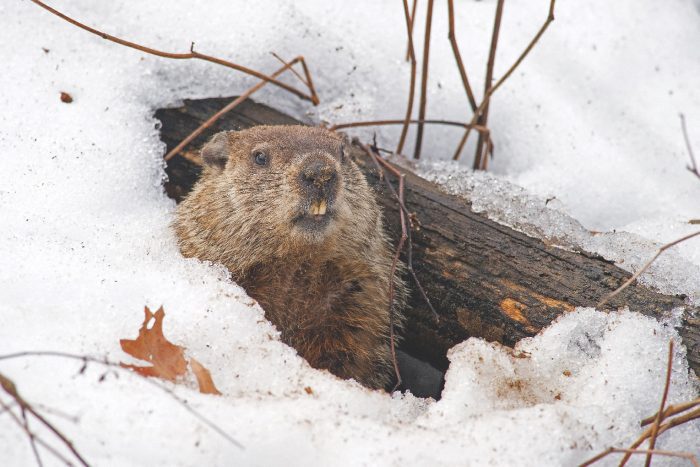Nature Matters: Water, ice and snow
By John L. Turner

Strolling on a mid-December day to pick up the morning paper at the base of the driveway, I passed by the bird bath and noticed the surface had a thin layer of ice capping a few inches of water underneath, an event about as surprising as the fact gravity held me to the ground as I fetched to get the newspaper.
Except that a thought I had not had for a very long time suddenly flashed to mind, from something I read in a middle school Earth Science textbook, a thought about a concept that is remarkably consequential — if ice wasn’t lighter than water but rather denser, life might not have ever gotten a foothold on planet Earth or if it did, it might have happened later and in a much more limited fashion geographically speaking.
As water cools it becomes denser so water closer to a freezing temperature, say 40 degrees Fahrenheit, is denser than at 80 degree water and 80 degree water is denser than water near its boiling point. The fact the colder water is, the denser it is, is true — but only to a point. Once water falls below 39.4 degrees Fahrenheit it reverses course density wise and becomes less dense as water molecules shift to form a lattice-like structure of spread out interconnected hexagons (six sided) once the water freezes; this lower density explains why ice is always on the surface and why ice cubes and icebergs float.
If water lacked this chemical quirkiness (in one scientific account characterized as ‘anomalous physical behavior’) and ice was denser than water, when ice formed at the surface from contact with air below 32 degrees, it would sink to the bottom, soon freezing solid the entire water column from bottom to top and everything in between if it stayed cold long enough.
All turtles, frogs, salamanders, and fish would be frozen along with the much smaller zooplankton that forms the base of the aquatic food chain located in temperate climates. Aquatic mammals such as beavers, muskrats, and otters would struggle mightily to survive. The same would be true for bays, harbors and the shallow portions of oceans, creating profound difficulties for the animals living in the colder portions of the marine realm.
If ice was denser than water would life ever have evolved on Earth? If so, would it be in the countless forms we see today? Would there have been other evolutionary pathways than the traditionally understood fish to amphibian to reptile to bird and mammal route we have deciphered from genetic evidence and the fossil record? Would you or I even exist to read and write this article, respectively?
Fortunately, our world is one in which water behaves oddly, with ice always floating on water, forming a protective layer for the free swimming aquatic life beneath. No matter how cold and bone-chilling the temperature of the air, even in circumstances involving temperatures much below zero (as routinely happens in mountainous areas and the polar regions), the water beneath the ice remains a ‘balmy’ 33 degrees or slightly higher, allowing for life to persist.
And ice isn’t the only form of frozen water that protects life. Snow does the same. One foot of snow is enough to keep the soil near 32 degrees despite what the air temperature is above the snow. This insulative value is not surprising given the fact that about 90% of the volume of a freshly fallen blanket of snow is air!
This allows for small mammals like voles and mice to remain active through the winter, hidden from predators beneath the snow, although a life free from predation is never a guarantee; a fact borne out on a few occasions when I’ve seen both red fox and coyote spring high into the air, arching their backs to gain momentum and focus, coming hard down on the snow with their front paws to punch through the crusty surface layer of snow in pursuit of a vole or mouse it heard below.
I well remember watching a coyote in a wind-blown, snow-covered farm field in Ontario, north of Ottawa, about thirty winters ago repeatedly pouncing through the snow, eventually catching what looked like to be a meadow vole.
Snow also enables animals hibernating beneath (called the subnivean zone) to use less energy and worry less about frostbite during this vulnerable time. Snow also protects plants from “frostbite” by preventing the soil from freezing and damaging small roots and rootlets. That’s why snow is referred to as the “poor man’s mulch”! The snow prevents a freeze-thaw-freeze-thaw cycle which can push or heave a plant from the soil causing root damage.
And a snow cover benefits human animals and their properties too, by safeguarding underground water lines from freezing since slightly below the snow-covered surface the temperature remains above the freezing point. This might not be true if very cold air can make prolonged contact against a ground that lacks the benefit of a snow blanket.
Under certain conditions though, snow and ice can prove lethal to plants and animals. The weight of wet snow can break branches and occasionally break or topple trees, especially evergreens whose abundant needled leaves hold snow. Ice forming inside plant and animal cells can be lethal as microscopically small ice shards puncture cell walls.
The wood frog, a native amphibian that breeds in vernal pools throughout Long Island (vernal pools will be the subject of a Nature Matters column in the Spring of 2025) actually freezes solid in the winter and is able to survive by pumping water out of its cells so they stay protected. No wonder they are amusingly called ‘frogcicles’!
If you want to see a wood frog thawing out after a long winter of being frozen but somehow still staying alive, I invite you to look at YouTube videos.
So there you have it — ice and snow — two substances which can disrupt life in specific situations but lifegiving in a general sense. And since we’re still in the glow of the holiday season, let’s be forever thankful for the unique, life-permitting nature of water molecules.
A resident of Setauket, author John L. Turner is a naturalist, conservation co-chair of the Four Harbors Audubon Society, and Conservation Policy Advocate for the Seatuck Environmental Association.







